We think of Rapid Transit service as a fact of life, infallible and ever-existent since the dawn of time. Hell, people must have thought that when the original constituent companies of the CTA first formed back in the late 1890s. Unfortunately, history has a funny way of being oh-so-reductive. Instead, we'll close out our compendium of Chicago transit with a small history on the beginnings and current operations of the Chicago Transit Authority. We'll keep the intro short this time around, because we have a lot to get through.
-----
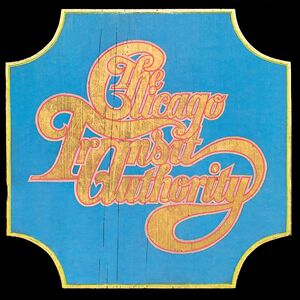

The story of the Chicago Transit Authority begins on April 28, 1969, when their first self-titled album was released to rave reviews. Robert Lamm and Terry Kath...
Wait, not that Chicago Transit Authority? The one about trains?
Oh. Oh, I misread this all wrong. Ok, start again.
-----
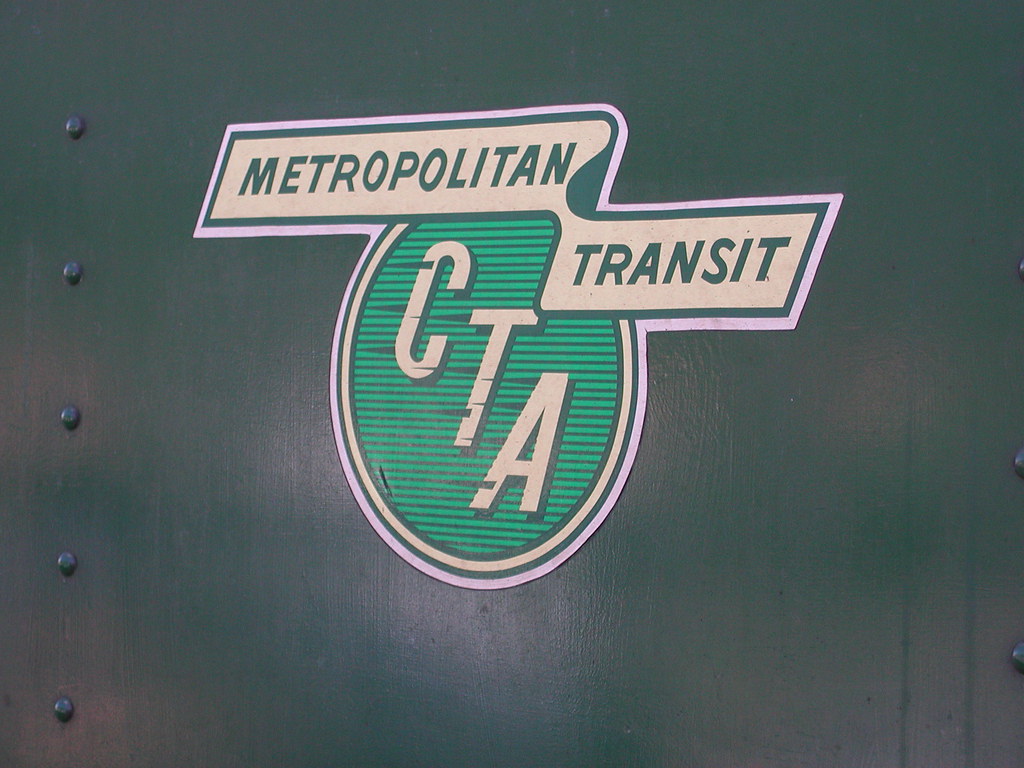 |
| I'm pretty sure this is the right one. Anyway... (S Jones) |
Before October 1, 1947, both the Chicago Surface Lines (CSL) and the Chicago Rapid Transit Company (CRT) handled the Second City's public transit as a private venture. Each company was made up of several constituent companies operating under a single consortium, with the CSL being made up of the Chicago Railways, Chicago City Railway, Calumet & South Chicago, and the Southern Street Railway; the CRT was made up of the Northwest, South Side, Lake Street, and Metropolitan West Side Elevated railways. Both companies employed liberal transfers among their constituents, enabling a pseudo-municipal system that was convenient to the rider and profitable to the operator without anyone screwing each other over. New innovations were also developed in this privatised period, like multiple unit train control on the South Side Elevated, and the new President's Conference Committee (PCC) streamlined streetcars that could reduce operating costs and maximize passenger numbers.
 |
| A Chicago Rapid Transit Lines pamphlet cover from the 1920s. (CTAGifts.com) |
 |
| The Lake Street L first gained its Skip-Stop service on April 18, 1948, between Hamein and Clinton Streets. This may have saved the line from a premature retirement. (The Trolley Dodger) |
In 1948, the CTA introduced "A", "B", and "A/B" station codes on the Lake Street Line during rush periods. To combat the limitations of two-track lines and old rolling stock (most of which were still from the early 1900s), stations were split into "A" and "B" stops with the relevant trains only hitting up one or the other. The "A/B" service were designated "All Stops" and considered local trains. In the next two years, 33 "Low use" stations were closed up and down the elevated and even the subways. Yes. Chicago had subways and two were opened and operated under the CTA.
| The State Street subway opens on October, 1943, with the first train outbound to Ravenswood and Albany Park. Don't stand so close to the tracks. (Getty Images) |
 |
| The first 6000 series arrive from St. Louis Car in 1951. Archival footage provided by CTAConnections. (CTA Connections) |
 |
| Phase 1 of the Dearborn and State Street Subways, which eventually connected to the west side of the Congress Expressway. (CERA) |
Further service discontinuations continued through the 1950s, with rail service on the Westchester Branch being replaced by buses in 1951 and the Wells Street terminal being demolished in 1955. The Chicago Aurora & Elgin closing abruptly in 1957 left a major service gap that was not helped when the Stock Yard and Kenwood branches were also closed by December of 1957. In their various attempts to "Beeching Axe" their services, CTA also retired their wooden fleet by the end of the year when the Kenwood branch closed. Most of CSL's lines were converted to trolley or motor bus service by the mid 1950s, and what they couldn't "bustitute" was simply abandoned by 1958. These closures, however, did not stop progress, as by June 22, 1958, the Congress Line opened on the median of the Congress Street Expressway (Now the Eisenhower Expressway) to replace the quickly-demolished Garfield Park Line. Only the 6000s initially ran this line, as it was the crown jewel of CTA's system and the first in-median transit line in the world.
 |
| The Congress Line, 1967, with a train west bound at Kostner. (CERA) |
 |
| The Skokie Swift's initial service in May 1964, featuring a spoilered trolley pantograph to ensure the pole maintains contact at high speeds. (Roger Puta) |
The 1960s brought so many technological advances (and old faces) to the CTA, beginning with the introduction of the train-phone system on board the North-South route (which took over operations between Howard-Englewood and Normal Park). This allowed motormen to contact Operations Control at CTA's Merchandise Mart offices. Lake Street also received new elevated tracks on its west end, sharing right-of-way with the Chicago & North Western. Following the end of the North Shore Railway on January 21, 1963, CTA assumed their operational routes through Niles Center and Evanston and opened the "Skokie Swift" the following year. The "Swift" was a unique operation when it opened, as the addition of a "Park n' Ride" lot in Dempster Street and its federal dollar financing meant it was one of the first examples of "Light Rail" in the world.
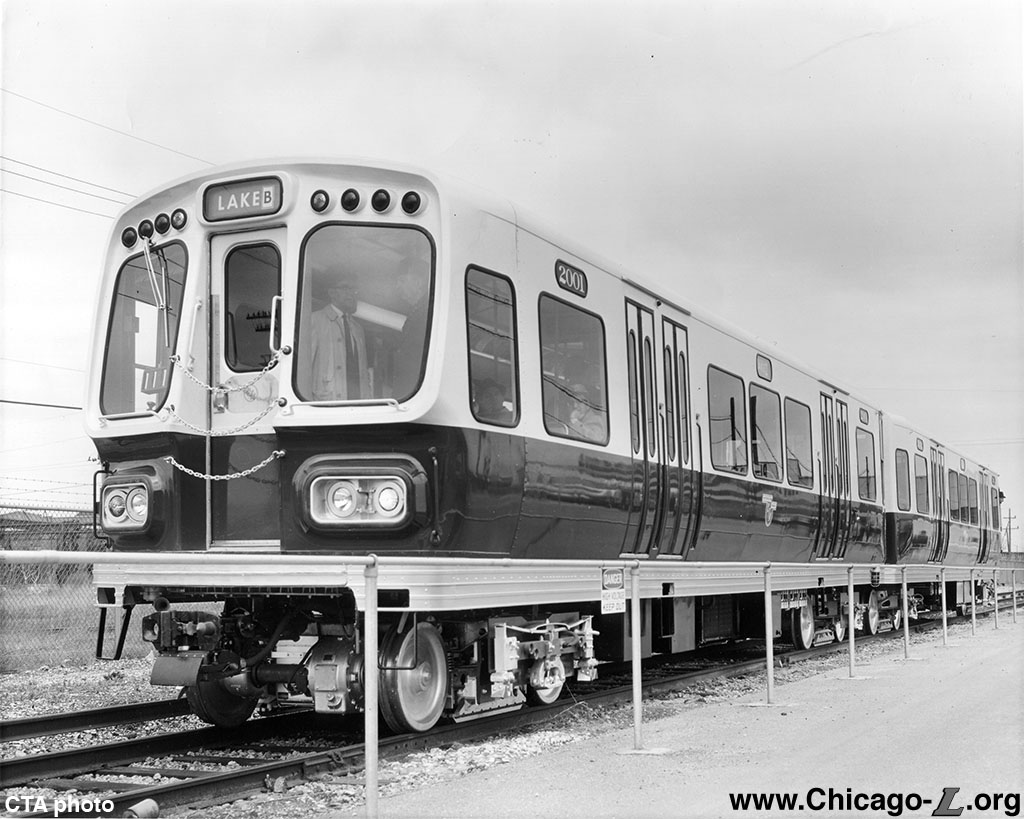 |
| The prototype 2000-series from Pullman Standard, April 22, 1964. Note the "Lake B" destination board. (Chicago-L.org) |
1964 also brought with it the 2000-series "High-Performance" rapid-transit vehicles built by the Pullman-Standard company. These built on the advances made by the 6000-series cars and included sculpted fibreglass ends, remote-controlled destination signs, more powerful motors, and, in 1967, automatic cab signals. These signals were designed to alert the motorman to any obstacle or trains on the line, and soon became a standard for railways all across America. The 2000s assigned to the Lake Street route received their signals first, then it was spread to the whole system. These cars were later surpassed in 1969 by the Budd-built 2200-series stainless steel cars, which were lighter and more fire resistant. They were introduced on the Dan Ryan Line on September 28, 1969, which was Chicago's second in-median rail line following the new Dan Ryan Expressway, but also worked on the Loop Shuttle (a local service using the Loop's inner track) starting the next day.
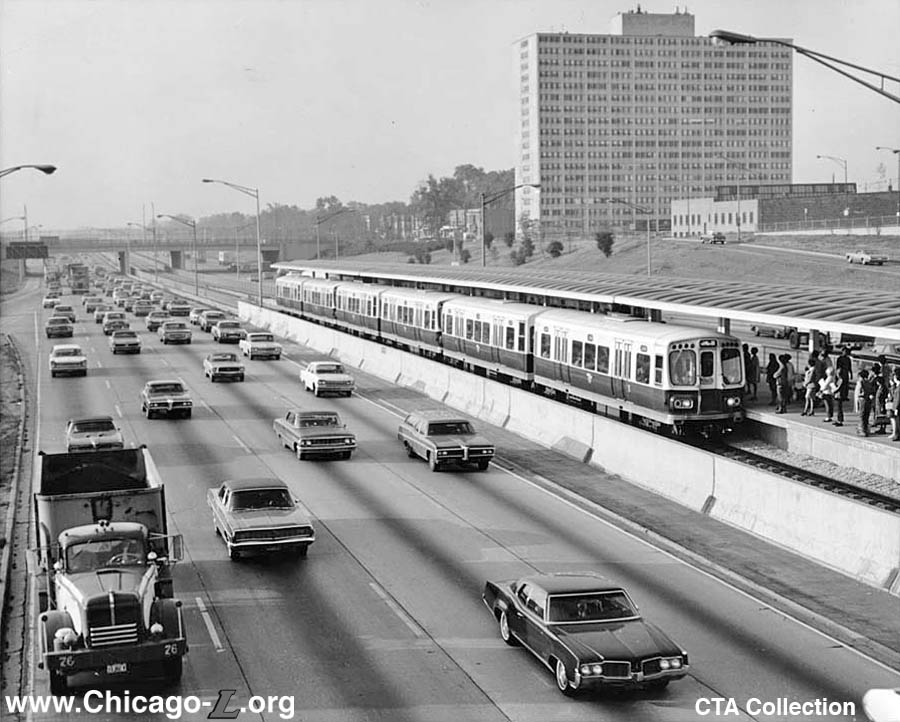 |
| The Dan Ryan Expressway on October 1, 1969, with the new 2000-series cars in service. (CTA Collection, Chicago-L.org) |
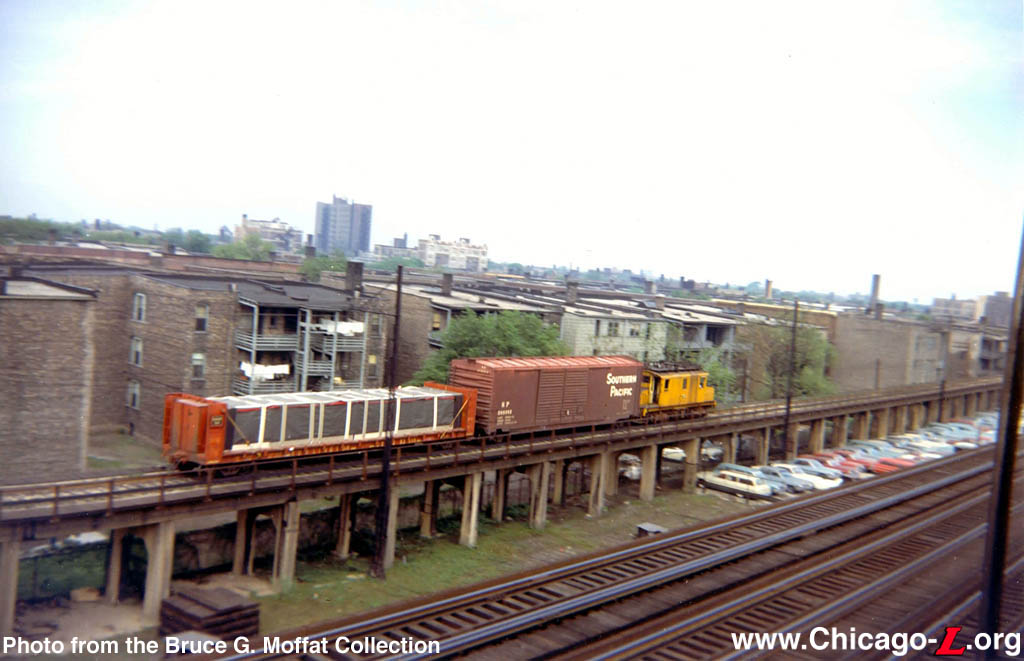 |
| A CTA electric locomotive hustles towards Buena Yard, Chicago, in the mid-1960s. (Bruce G. Moffat Collection) |
 |
| Some CTA 4000-series cars (from a later order in 1923) were retained as part of the MOW fleet. (Steve Zabel) |
| A contemporary advertisement for the new 2400-series by Boeing Vertol, in patriotic red, white, and blue. (Chicago Patterns) |
This gap in the fleet met it possible for Boeing Vertol to introduce the 2400-series on October 1976, featuring new handicap accessibility, a separate motorman's cab, sliding doors, and a lightweight fibreglass body (not just the front). To celebrate the nation's bicentennial, the new cars were dressed up in a flashy red-white-and-blue paint scheme similar to the Amtrak Turboliners, and joining them was CTA's first black female operator, Mary Wallace, who was hired just two years prior on August 29, 1974. The Loop Shuttle was the last closure of the 1970s, discontinuing service on September 30, 1977, and the Loop itself would have gone with it, but this plan to demolish both a Chicago icon and an important element of Chicago's transit system never left the drawing board.
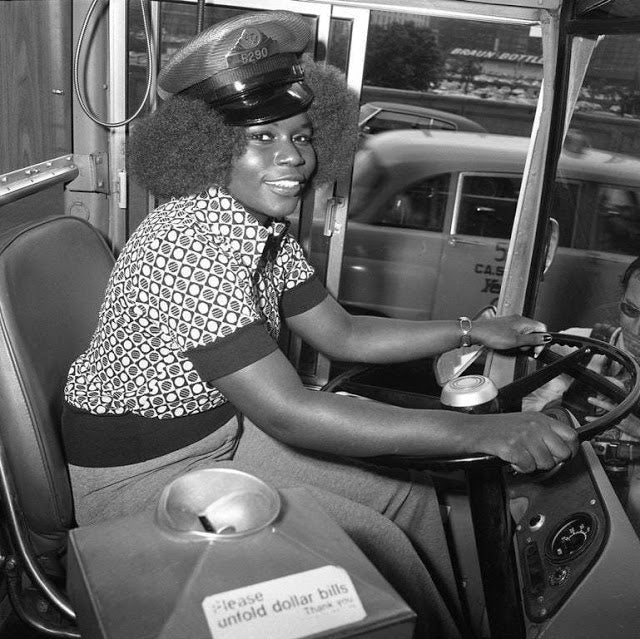 |
| Mary Wallace, first female operator for the CTA. Read more about her at The Wonder Woman Project. (Wonder Woman Project) |
 |
| The aftermath of the 1976 CTA Collision. (Chicago Fire Department) |
The 1970s also saw two of the worst accidents in Chicago transit history, happening back to back in 1976 and 1977. On January 9, 1976, two trains collided during the morning rush hour at Addison Street Station, along the Kennedy extension. Southbound "B" train 316 struck "A" train 104 after continuing issues with the automatic train control (ATC) meant train 316 bypassed its cab signal at Irving Park (the previous station) and continued on as normal. Visibility factors and glare meant the motorman had little time to react, colliding at speed with the standing train 104 and crashing both. Only one of the 381 passengers injured died, and the National Transportation Safety Board found the CTA negligent in handling its operating procedures and the motorman negligent of speeding and failing to stop and call when he passed through Irving Park. This was considered the worst accident in CTA history, until...
February 4, 1977. Dubbed "The Loop Crash", it was the worst accident in Chicago Transit history due to its unusual circumstances, the level of damage, and the fatalities. It started with the Evanston Express being diverted onto the outer loop track and performing "left-hand running" due to switching problems. (American trains in general drive the same as American cars, on the right. Unless you're weird like certain sections of the C&NW.) While this switch issue was eventually fixed, many Evanston-bound trains were still running on the opposite line, leading to a situation where now a Ravenswood-bound train was stuck behind and an Oak Park-bound train was unloading in front at Randolph/Wabash Street. Motorman Stephen A. Martin, a veteran of the CTA since 1969, seemingly forgot about the Evanston and Ravenswood trains and started up his Lake-Dan Ryan-bound train, even after cab signals were telling him about the block and the Ravenswood train waiting at the end of the curve outside Randolph/Wabash. Due to his speed falling well under 15-mph, the ATC could not stop his train. A collision was imminent.
 |
| The first three cars of the Lake-Dan Ryan train, and the rear car of the Ravenswood train, on the ground at Wabash and Lake, February 4, 1977. (Chicago Tribune) |
 |
| CTA 2600 No. 2842 at the Cicero-Berwyn Terminal of the Blue Line, July 17, 1994. (Leon Kay) |
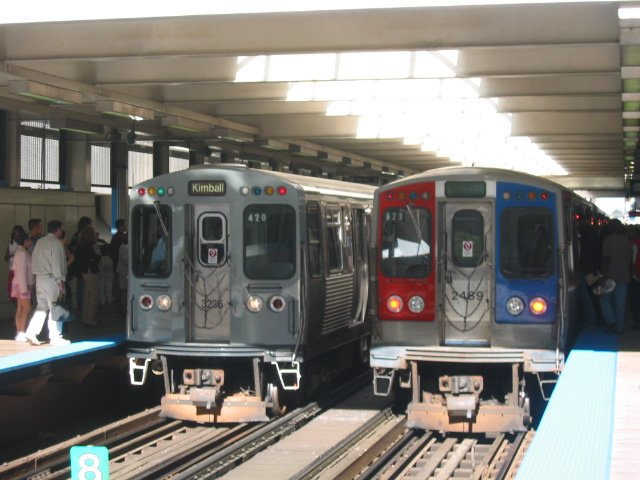 |
| Morris Knudsen 3236 lines up next to Heritage retainer 2489 at Clark/Lake, July 24, 2003 (Oren's Transit Page) |
 |
| The CTA as it appears now, with more added services like the Pink Line (which opened in 2006). (CTA) |
In 1997, the CTA celebrated its 50th anniversary and the Loop celebrated its 100th anniversary. One of the oldest pieces of the line, the Cottage Grove-Dorchster section of the Green Line, was finally removed after 105 years of service. The fact that it was removed without warning the communities involved increased hostility between the CTA and their neighbors. Many employees were also laid off at this time, as the Red and Blue lines went into one-man operation, the last of the elevateds to do so. Conductors are still used on the subway for safety reasons, while ticket agents were rendered redundant in favor of automated ticket machines. Further service cuts in 1998 were worse for the buses, but Owl (nightly) service being cut on the Green, Purple, and Blue Lines (via Douglas branch) was softer on rails by comparison.
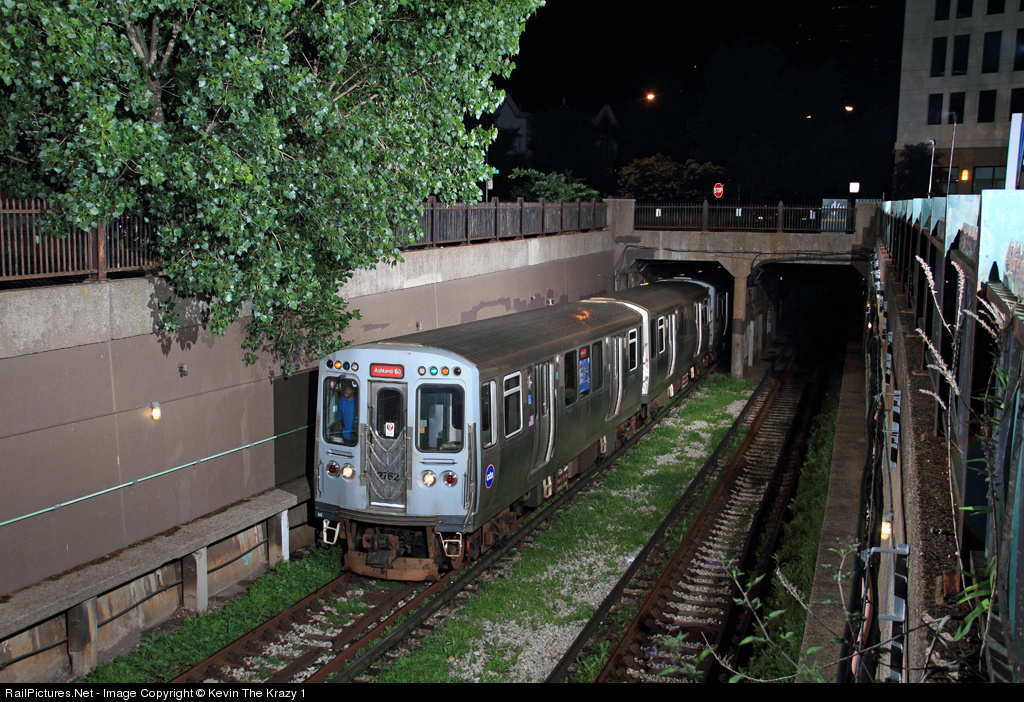 |
| CTA 2600-series No. 2762 is southbound on the Red Line out of the State Street Subway in 2013. (Kevin the Krazy 1) |
By 1999, after a massive snowstorm in July knocked out half the system, several corrections and flaws were exposed to help the CTA prep itself for the new millennium. Conductors were returned to the trains due to a reduction of service and cars were reshuffled when nearly 300 2600-series cars go down, requiring 3200s to take over all over the system. CTA also used this time to retire tokens in favor of Transit Cards and cash fares as payment, and reopen the Grand/Milwaukee Station once more after it was closed in 1992 during service revisions. The last "tradition" of the CTA to go, the conductors, finally went on March 25, 2000 when they were replaced by automated voice announcements and safety monitors for the motorman to control.
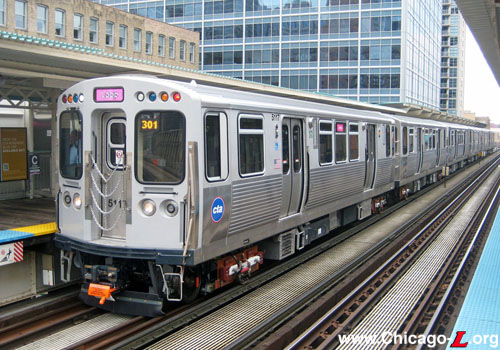 |
| The new Bombardier 5000-series in 2009. (Graham Garfield) |
 |
| "Pardon me, where's Gate 32?" (NTSB) |
 |
| A pair of Bombardier 5000 classes move aside for the Cincinnati Car Co. 1923 4000s to pass them. The heritage run is en route to Howard station during the CTA's 2017 Transit Jamboree. (Jonathan Lee) |
Today, the CTA is continuing to look into the future with new extensions, improvements, and rolling stock to ensure the elevated remains competitive. Plans like the "Red Ahead" propose flyovers to replace diamond junctions to reduce service backups, while a southern extension for the Red Line would see it meeting the South Shore Line down Michigan Avenue. New cars like the CRRC Sifang 7000 class are also imminent to replace the aging 2600 fleet. On the flipside, the CTA has still not forgotten its heritage, with a small fleet of two 1923 4000-series CRT cars, four 6000-series cars, eight Red-White-and-Blue 2400-series cars, and three 1960s buses all giving Chicagoans a taste of the past. After its long, convoluted, and extensive history, the wind continues to rise for the CTA, and this is only the beginning...
-----

With a variety of transportation options, the city provides convenient solutions for all types of travelers. Chicago transportation companies offer everything from taxis to luxury vehicles, ensuring a smooth ride for both locals and visitors. These services are efficient, reliable, and perfect for navigating the bustling urban environment.
ReplyDelete